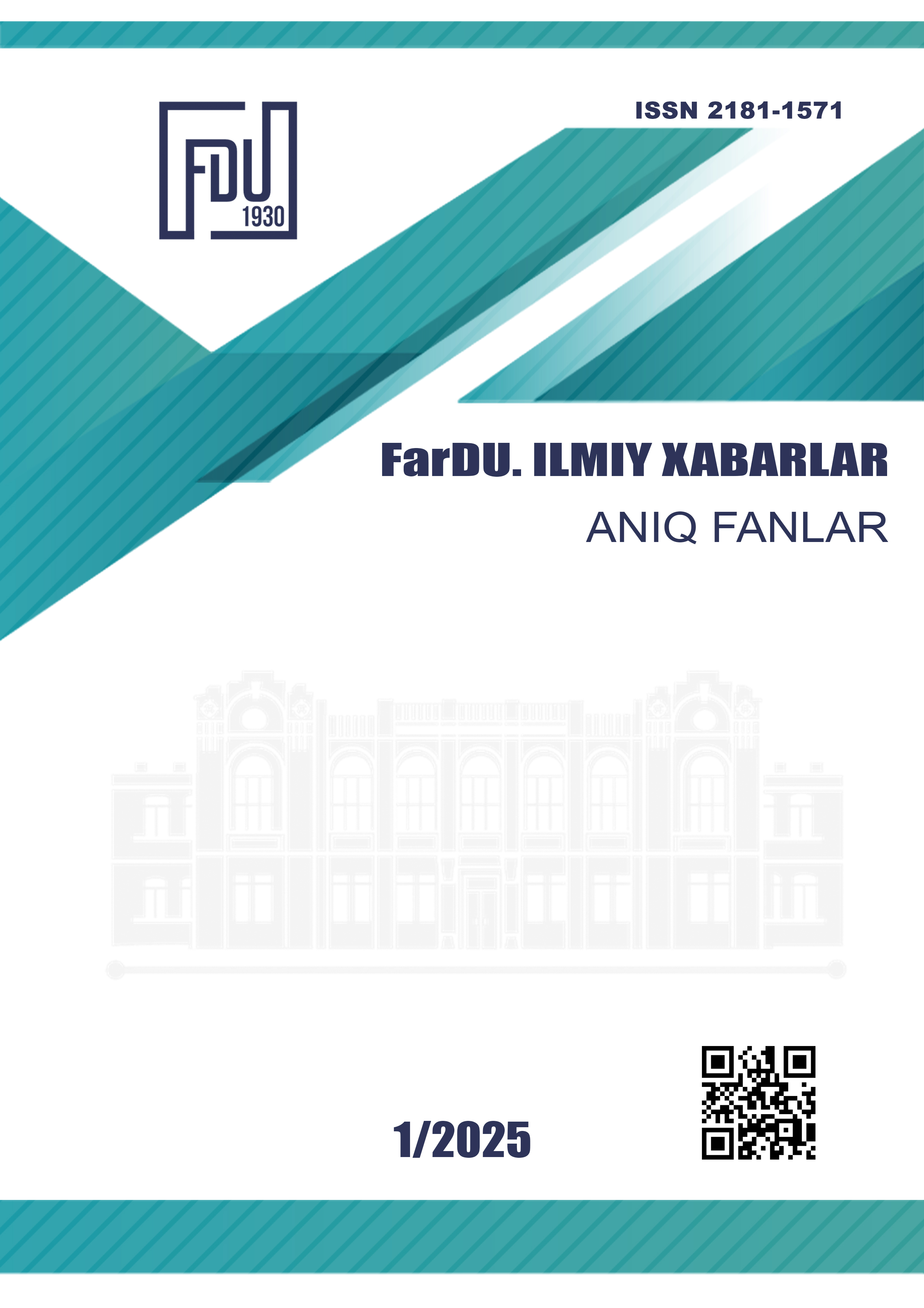ANALYSIS OF THE CONTENT OF WATER-SOLUBLE VITAMINS IN THE FOOD SUPPLEMENT AS-RAZZOQ
Keywords:
Rosa canina L., Glycyrrhiza glabra L., vitamin, HPLC, vitamin C, immunostimulantAbstract
The vitamin content in water extracts of local medicinal plants, specifically Rosehip (Rosa canina L.) and licorice (Glycyrrhiza glabra L.), was studied experimentally. To determine the vitamin content in the extracts, various sources were utilized: Vitamin B12 from Rhydburg Pharmaceuticals (Germany), vitamin C from Carl Roth GmbH (Germany), vitamin B9 from DSM Nutritional Products GmbH (Germany), and vitamins B1, B2, B3, B6, and PP from BLDPharm (China). HPLC-grade reagents such as water, acetonitrile, chemically pure acetic acid, and sodium hydroxide were also used. The vitamins were analyzed using an LC-40 Nexera Lite high-performance liquid chromatograph by Shimadzu (Japan). The water extract was prepared from a blend of rosehip fruits (Rosa canina L.) and licorice roots (Glycyrrhiza glabra L.) in a ratio of 75:25. This extract is found to be rich in vitamins. Based on its beneficial chemical composition, recommendations have been developed for its use in strengthening the immune system, treating upper respiratory tract diseases, and alleviating phlegm.
References
Асқаров И.Р. Табобат қомуси. Тошкент: Мумтоз сўз, 2019 й. 234-274-б.
Demir, N.; Yildiz, O.; Alpaslan, M.; Hayaloglu, A.A, “Evaluation of volatiles, phenolic compounds and antioxidant activities ofrose hip (Rosa L.) fruits in Turkey. LWT Food Sci. 2014, 57, 126–133. [”.
Ercisli, S, “Chemical composition of fruits in some rose (Rosa spp.) species. Food Chem. 2007, 104, 1379–1384.”.
Chrubasik, C.; Basil, D.; Roufogalis, B.D.; Müller-Ladner, U.; Chrubasik, S., “A systematic review on the Rosa canina effect and efficacy profiles. Phytother. Res. 2008, 22, 725–733”.
Turkben, C.; Barut, E.; Copur, O.U.; Durgut, E.; Himelrick, D.G.; Türkben, C.; Barat, E.; Çopur, Ö.U.; Durgut, E.; Himelrick, D.G, “Evaluation of rose hips (Rosa spp.) selections. Int. J. Fruit Sci. 2005, 5, 113–121”.
Iancu, P.; Soare, R.; Dinu, M.; Soare, M.; Dorina Bonea, D.; Popescu, M., “Analysis of the existing research regarding the use of the species Rosa canina L. Sci. Pap. Ser. B Hortic. 2020, 64, 325–331.”.
Раззаков Н.А., // Наъматак ва зирк ўсимликларининг кимёвий таркиби ва улар асосида янги озиқ-овқат қўшилмалари олиш // Диссертация. Андижон. 2022 й . 41 –б.
Gyamfi, M. A., Yonamine, M., & Aniya, Y. (1999)., “Free-radical scavenging action of medicinal herbs from Ghana: Thonningia sanguinea on experimentally-induced liver injuries. General pharmacology, 32(6), 661–667. https://doi.org/10.1016/s0306-3623(98)00”.
Эгамбердиев Д.У. Ширинмиядан халқ табобати учун биологик фаол товарлар олиш ва уларни синфлаш. Андижон. Диссертация. 2022й, 17-б.
Askarov, I. R., Abdulloev, O. S., Otakhonov, K. K., & Razzakov, Z. N. (2024). STUDYING THE ANTIOXIDANT ACTIVITY OF ROSEHIP AND LICORICE PLANTS. Journal of Chemistry of Goods and Traditional Medicine, 3(4), 320–340. https://doi.org/10.55475/jcgtm/vol3.iss4.2024.355
Askarov, I. R., Abdullaev, S. S., Mamatkulova, S. A., Abdulloev, O. S., & Abdulloev, S. K. (2024). DEVELOPMENT OF A METHOD FOR DETERMINING THE AMOUNT OF WATER-SOLUBLE VITAMINS USING THE HPLC METHOD (USING THE EXAMPLE OF JUJUBE). Scientific Journal of the Fergana State University, 30(5), 61. Retrieved from https://journal.fdu.uz/index.php/sjfsu/article/view/4679
Асқаров И.Р. Сирли табобат. – Т.: “Фан ва технологиялар нашриёт-матбаа уйи”. - 2021. – 281.
RAHMATOV O.B. BOLALAR YUQUMLI KASALLIKLARI, Toshkent: Cho‘lpon nomidagi nashriyot-matbaa ijodiy uyi, 2008.
Downloads
Published
Issue
Section
License
Copyright (c) 2025 Scientific journal of the Fergana State University

This work is licensed under a Creative Commons Attribution-NonCommercial-NoDerivatives 4.0 International License.
How to Cite
Most read articles by the same author(s)
- Mamatqulova Surayyoxon Abdusamatovna, Asqarov Ibrohimjon Rahmonovich, STUDYING THE FLAVONOID COMPOSITION OF THE BIOLOGICAL SUPPLEMENT OF ANICE AND CILORANT , Scientific journal of the Fergana State University: No. 3 (2024): FarDU.Ilmiy xabarlar jurnali (Aniq va tabiiy fanlar)
- Asqarov Ibrohimjon Rahmonovich, Madinabonu Xamdamova, METHODS OF USING WHEAT BRAN IN THE TREATMENT OF SOME DISEASES , Scientific journal of the Fergana State University: No. 4 (2024): FarDU.Ilmiy xabarlar jurnali (Aniq va tabiiy fanlar)
- , , ANALYSIS OF WATER-SOLUBLE VITAMINS IN THE «AS RHEUM» FOOD ADDITIVE OBTAINED BASED ON THE COMBINATION OF ALLIUM ODORUM AND RHEUM , Scientific journal of the Fergana State University: No. 3 (2024): FarDU.Ilmiy xabarlar jurnali. Ilova to'plam (Aniq va tabiiy fanlar)
- Ibrohimjon Rahmonovich Asqarov, Mo‘minov Mo‘ydinjon Mo‘minovich, Umidjon Xusanov Shokirjonovich, CHEMICAL COMPOSITION OF GULKHYRI (ALTHAEA OFFICINALS L) PLANT, ELEMENT ANALYSIS OF GULKHYRI OIL AND ITS SIGNIFICANCE IN FOLK MEDICINE , Scientific journal of the Fergana State University: No. 1 (2023): Scientific journal of the Fergana State University (Exact and natural sciences)
- Asqarov Ibrohimjon Rahmonovich, Inomidin Ilmidinovich Xomidov, CHEMICAL COMPOSITION OF THE FRUITS OF THE PLANT ZIZIPHUS JUJUBA AND THEIR APPLICATION IN FOLK MEDICINE , Scientific journal of the Fergana State University: No. 4 (2023): Scientific journal of the Fergana State University (Exact and natural sciences)
- Mamatqulova Surayyoxon Abdusamatovna, Usmanova Tursunoy Erkinovna, Asqarov Ibrohimjon Rahmonovich, DETERMINATION OF THE AMOUNT OF FLAVONOIDS IN PAULOWNIA AND ROSMARINUS PLANT LEAVES , Scientific journal of the Fergana State University: No. 3 (2024): FarDU.Ilmiy xabarlar jurnali (Aniq va tabiiy fanlar)
- , , , CHEMICAL COMPOSITION OF CERTAIN SYNTHETIC DRUGS USED IN KIDNEY AND URINARY BLADDER DISEASES , Scientific journal of the Fergana State University: No. 4 (2023): Scientific journal of the Fergana State University (Exact and natural sciences)
- Asqarov Ibrohimjon Rahmonovich, Ubaydullayev Komiljon Tursunboyevich, PROSPECTS OF USING SAFFRON IN THE TREATMENT OF PARKINSON'S DISEASE IN FOLK MEDICINE , Scientific journal of the Fergana State University: No. 1 (2023): Scientific journal of the Fergana State University (Exact and natural sciences)
- , , DETERMINATION OF THE QUANTITY OF VITAMINS CONTAINED IN HYPERICUM PERFORATUM , Scientific journal of the Fergana State University: No. 3 (2023): FarDU ilmiy xabarlari jurnali (Aniq va tabiiy fanlar)
- Ibrohimjon Rahmonovich Asqarov, DETERMINATION OF ANTIRADICAL ACTIVITY OF PLANT EXTRACTS , Scientific journal of the Fergana State University: No. 2 (2024): FarDU.Ilmiy xabarlar jurnali (Aniq va tabiiy fanlar)

